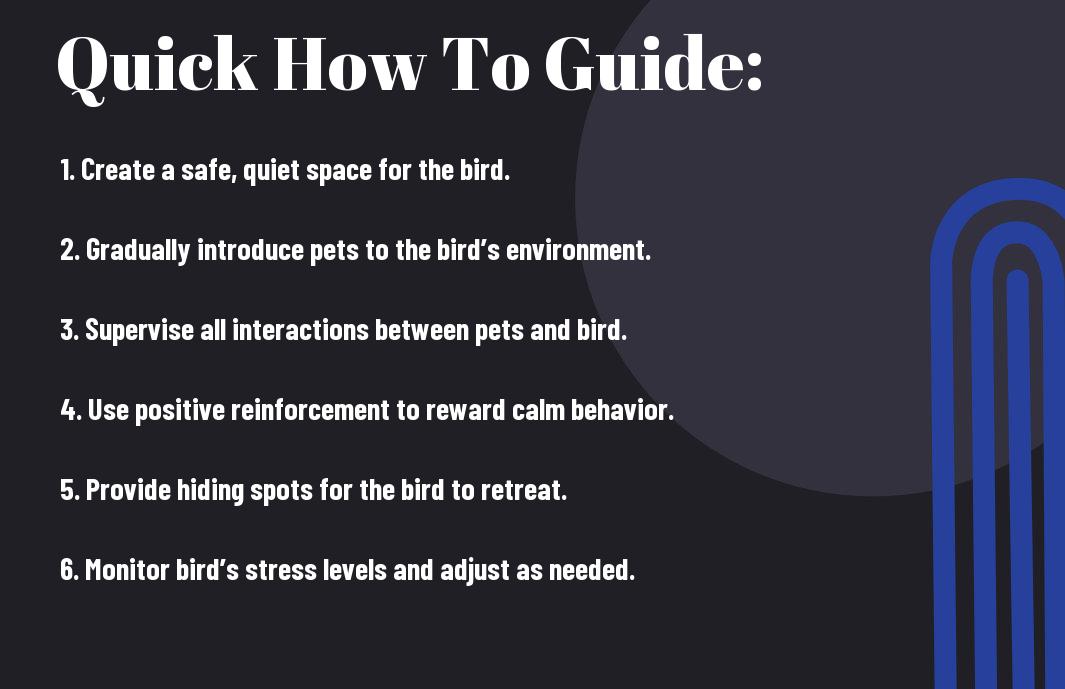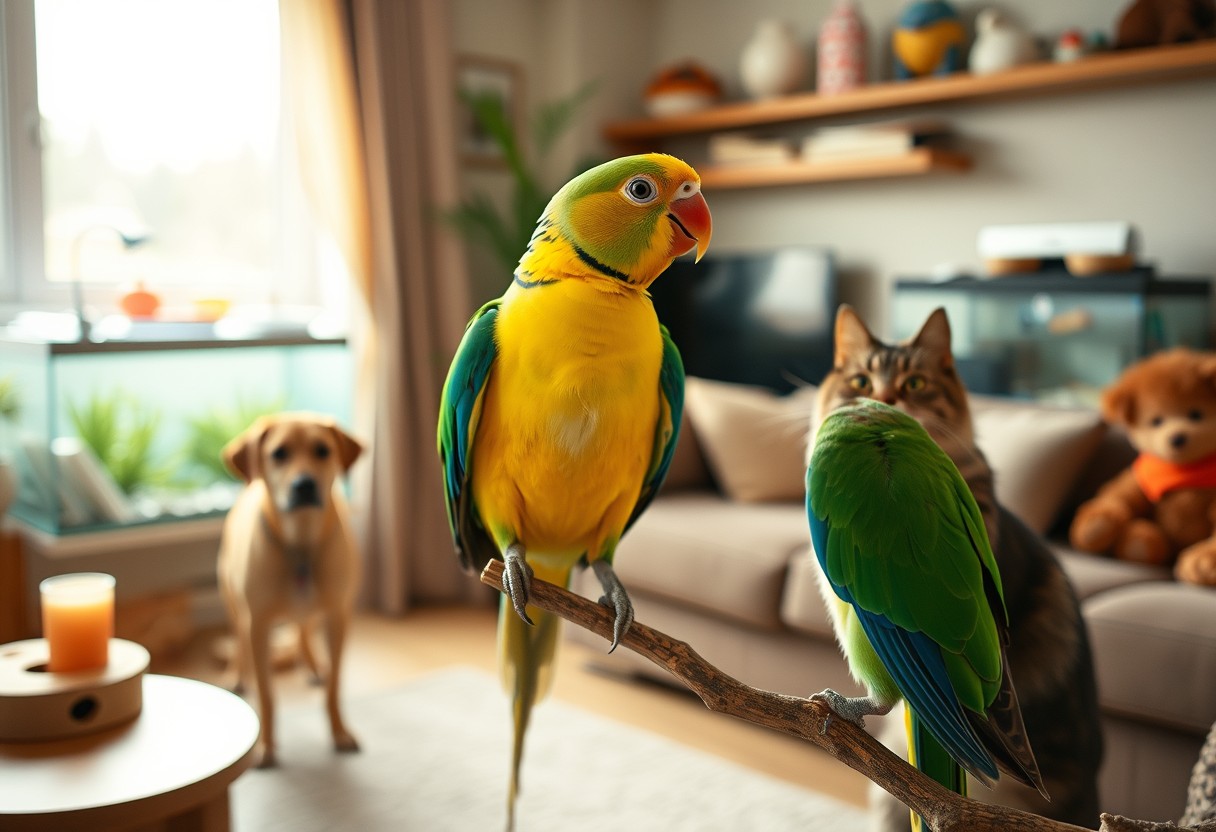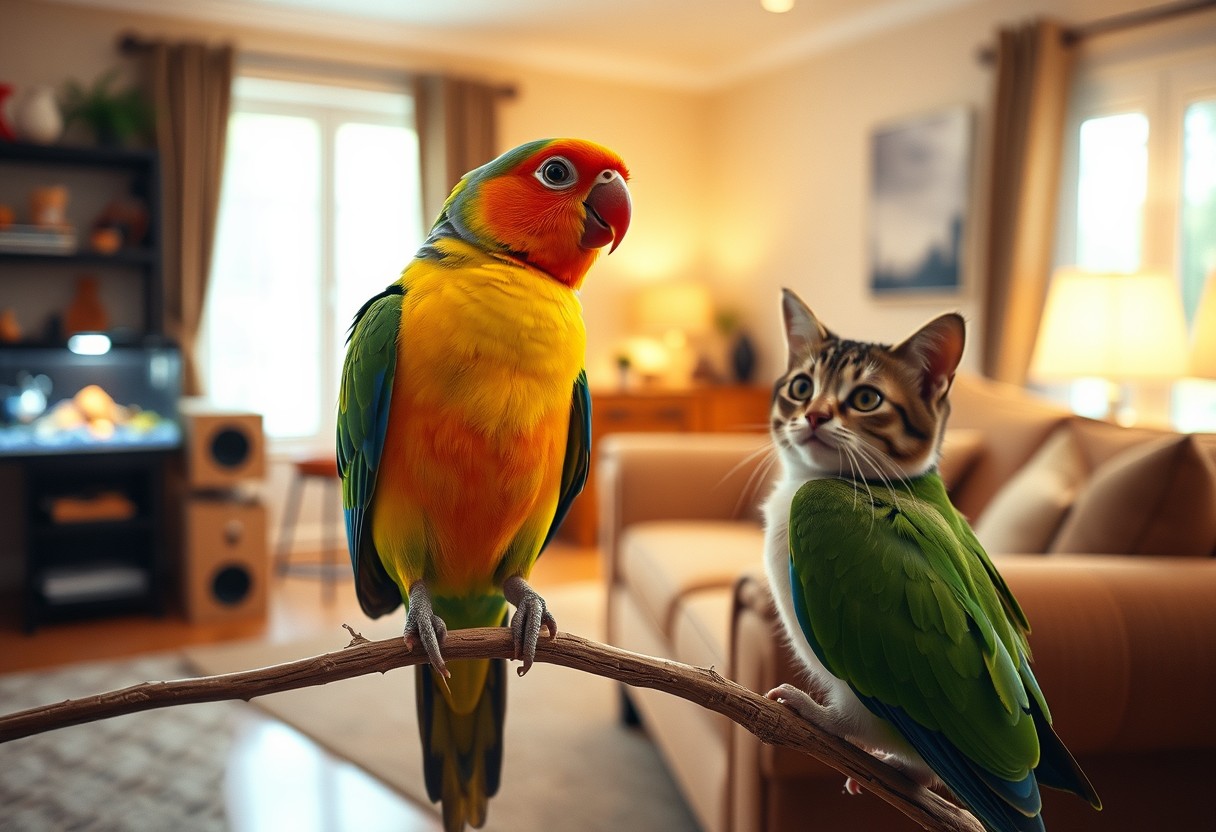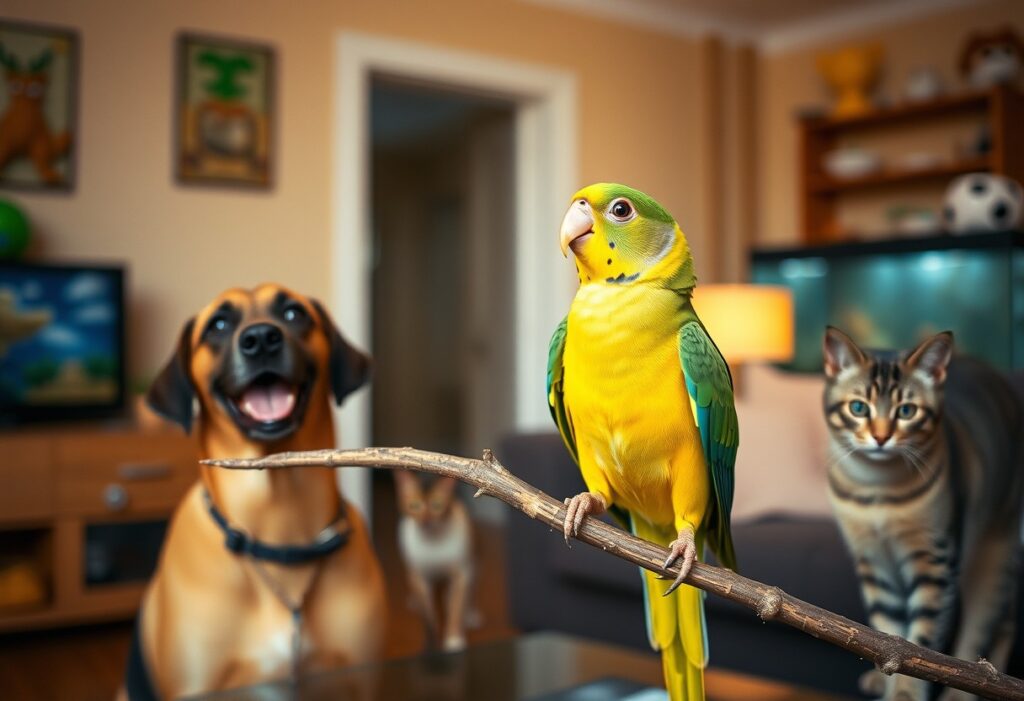This guide will help you navigate the challenges of caring for a bird that’s afraid of other pets. Understanding your bird’s behavior, providing a safe environment, and implementing gradual introductions are important steps for reducing their anxiety. You can create a harmonious home where your feathered friend feels secure and loved, while also ensuring the safety of your other pets. By following these strategies, you’ll be well on your way to fostering a peaceful coexistence among all your furry and feathery family members.

Understanding Your Bird’s Fear
While it may be easy to overlook a bird’s emotions, understanding its fear is crucial to fostering a harmonious environment, especially when you have other pets. Birds, being prey animals, can be particularly sensitive to their surroundings and the presence of other animals. Addressing these fears not only ensures the well-being of your feathered friend but also helps in maintaining peace within your home.
Recognizing Signs of Fear
On a fundamental level, recognizing signs of fear in your bird can often be the first step toward addressing it. Common signs include hiding in corners, vocalizing excessively, or exhibiting nervous behaviors like fidgeting and feather puffing. If your bird becomes unusually quiet or refuses to eat when around other pets, these can also be indicators of fear.
Additionally, you may notice your bird flapping its wings rapidly or attempting to fly away when other pets come near. Such behaviors signal extreme discomfort and should not be ignored, as prolonged stress can lead to significant health issues. By being observant, you can identify these fear responses and start paying closer attention to your bird’s needs.
Factors Contributing to Fear of Other Pets
Your bird’s fear of other pets can be influenced by various factors. The size and behavior of the pets in your household play a significant role. For instance, a large dog or a noisy cat may naturally intimidate a small bird, leading to increased stress levels. Past negative experiences with other animals can also create lasting fears, making your bird more wary of unfamiliar pets.
- Size disparity between the bird and other pets
- Past trauma from interactions with animals
- Body language of other pets, such as aggression or playfulness
Furthermore, the manner in which you introduce your bird to other pets can heavily influence its response. Quick and abrupt introductions can lead to distress, whereas gradual approaches may help ease your bird into the new environment. Knowing the underlying factors can enable you to create a safer atmosphere for your bird.
To alleviate your bird’s fear effectively, it’s crucial to provide a safe space where it can retreat when feeling threatened. Establishing a proper environment where your bird can observe other pets from a distance can mitigate stress. Create a routine that allows your bird to become familiar with your pets over time, rather than forcing interaction. This gradual exposure is key to building your bird’s confidence. Additionally, monitor your pet interactions closely, ensuring that your bird’s experience is positive. Knowing these strategies can significantly improve your bird’s overall well-being while promoting a peaceful coexistence with your other pets.

Creating a Safe Environment
Some birds can experience anxiety when introduced to or being around other pets. Therefore, it is crucial to create a safe environment for your feathered friend. This will not only ease their fears but also help in building their confidence. Taking proactive steps to ensure that your bird feels secure in its surroundings is vital for their well-being. This means considering their interactions with other pets and being mindful of your bird’s needs when setting up their space.
Safe Spaces for Your Bird
To help your bird feel more at ease, you should create designated safe spaces within your home. This can be achieved by providing them with areas that are out of reach from your other pets, where they can retreat whenever they feel scared. Utilizing high perches or bird stands situated in quiet corners can give your bird a sense of security, allowing them to observe their surroundings from a safe distance. Additionally, using soft blankets or covers over their cages at times of high activity can also help minimize stress.
Proper Housing and Setup
There’s much more to a bird’s housing than simply having a cage. It is necessary to ensure that your bird’s living arrangement is comfortable and inviting. This means choosing a cage that is appropriate in size, allowing enough space for your bird to move around freely without feeling cramped. Use natural materials for perches and include toys that encourage drama-free play. Make sure that their water and food bowls are placed in a location that minimizes conflict, allowing your bird to eat and drink without fear.
Bird cages should also be equipped with plenty of enrichment items that give them opportunities for mental stimulation. Incorporating various toys, swings, and different textures can keep your bird engaged while reducing their focus on the presence of other pets. Additionally, it’s beneficial to place the housing away from the foot traffic areas of your home, as frequent movement can heighten your bird’s sense of danger. Always remember to ensure that your bird’s environment is safe from potential hazards and that they have areas to retreat to when they need a break from interactions.
Birds can be sensitive creatures, and when they encounter other pets in your home, their fear may manifest in various ways. To ensure your bird’s well-being and happiness, it’s imperative to manage their environment effectively. This guide will provide you with practical steps to create a safe space and help your bird feel more comfortable, allowing them to coexist peacefully with your other animals.

Tips for Ongoing Management
Now that you have taken the first steps towards managing your bird’s fear of other pets, it’s necessary to have a consistent plan for ongoing management. By being proactive and observant, you can create a safe environment where your bird feels comfortable. Here are some tips to help:
- Maintain a safe distance between your bird and other pets during interactions.
- Use positive reinforcement to encourage your bird to engage more with its environment.
- Provide plenty of enrichment for your bird to help improve its confidence.
- Create a routine that includes time for your bird to socialize separately from other pets.
- Monitor the body language of both your pet bird and other animals to prevent misunderstandings.
Building Your Bird’s Confidence
To help your bird overcome its fear, focus on building its confidence in a controlled manner. Start by allowing your bird to explore its surroundings without the presence of other pets initially. You can introduce short, supervised interactions with your dog or cat when your bird is calm, rewarding desirable behavior with treats. This creates a positive association with the presence of other pets, gradually helping your bird feel more at ease.
To further boost confidence, provide interactive toys and setups that encourage natural behaviors. For instance, hanging foraging toys in your bird’s cage can keep it engaged and shift its focus away from other pets. Ensure the environment remains predictable and stable, as abrupt changes can heighten anxiety levels.
Maintaining Peace Among Pets
Some strategies can effectively maintain harmony among your pets while ensuring your bird feels secure. First, establish defined spaces for each pet, allowing your bird to feel safe without being overwhelmed by the presence of other animals. Use barriers like gates or separate rooms when necessary to keep your bird and other pets apart during initial introductions.
A crucial part of maintaining peace is to supervise interactions closely. Make sure to watch for any signs of stress or discomfort from your bird, such as flapping, squawking, or hiding. It’s necessary to address any negative behaviors immediately to avoid reinforcing fear. Establish routines where each pet receives equal attention, preventing jealousy or territorial behavior. Always monitor your pet’s reactions carefully, particularly with dominant animals that may unintentionally bully or frighten a smaller creature like your bird. Assume that a gradual acclimation and vigilance will lead to a more peaceful cohabitation over time.
To Wrap Up
Hence, managing a bird that’s afraid of other pets requires patience, understanding, and strategic planning. Start by creating a safe and secure environment where your bird can feel comfortable, away from potential threats. Gradually introduce your pets to your bird by controlling their interactions and ensuring that both parties have positive reinforcement during these encounters. This process may involve using barriers like cages for initial introductions and rewarding your pets for calm behavior, which will help instill a sense of safety in your bird.
Additionally, it’s necessary to provide mental stimulation for your bird, as this can help reduce anxiety and fear over time. Engaging your bird in play activities, offering toys, and maintaining a consistent routine can foster confidence and a sense of security. With diligence and care, you can create a harmonious living situation where your bird feels safe and your other pets coexist peacefully, ultimately leading to a more enriching home environment for all of your beloved animals.
Q: What are the signs that my bird is afraid of my other pets?
A: Birds may exhibit several signs of fear when around other pets, including retreating to the farthest corner of their cage, puffing up their feathers, vocalizing loudly or frantically, and refusing to eat or drink. Additionally, they may try to hide or become overly aggressive if approached by another pet. Monitoring their behavior closely can help you identify when they are feeling threatened.
Q: How can I introduce my bird to other pets safely?
A: The key to a successful introduction is to do so gradually and in controlled settings. Start by keeping your bird in a secure cage while your other pets are nearby but under control. Allow them to see each other without direct contact, giving your bird time to adjust to the presence of the other animals. Gradually, as your bird becomes more comfortable, you can allow supervised interactions outside of the cage, ensuring that your other pets are calm and attentive. Always prioritize your bird’s comfort and safety during this process.
Q: What should I do if my bird continues to be scared of my other pets?
A: If your bird remains fearful despite repeated attempts at gradual introductions, it may be best to establish boundaries and routines that keep them separated. Create a safe haven for your bird where they can retreat when feeling threatened. You may also want to provide environmental enrichment for your bird, such as toys and perches, to help reduce their anxiety. Consulting with an avian veterinarian or a pet behaviorist can also provide insights and strategies tailored specifically to your situation. The goal is to ensure both your bird and other pets feel secure and comfortable in their shared environment.











